A bit more about COLLISION
Author's Notes & Featured Creatures. *If you are yet to read COLLISION, beware of spoilers!
shout outs
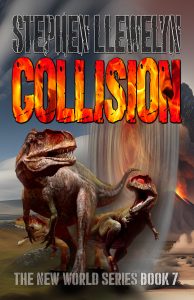 COLLISION is Book 7 in the New World series where Science Fiction and Historic Fiction merge into 100 million years of epic adventure.
COLLISION is Book 7 in the New World series where Science Fiction and Historic Fiction merge into 100 million years of epic adventure.
The final author’s notes of the series, where I try to remember everywhere I’ve taken liberties with history or science, or where the narrative didn’t allow for full explanation. Actually, this time, it feels more like trying to make sure I haven’t forgotten anything! With that in mind, I thought I’d start these notes with a couple of mentions.
Firstly, Geoff Lloyd used the phrase ‘deaf as Drake’s gunner’, my respectful homage to the late, great Richard Carpenter, who wrote some of my favourite shows from the 70s and 80s. It’s remarkable how some things can influence and stick with you. I actually wrote that line thinking it was my own but something about it gnawed at me and then I realised where I’d heard it before. I could have changed it, of course, but I thought I’d explain it in my notes instead, so that anyone reading this might look into some of Carpenter’s work for themselves and maybe enjoy it as much as I did.
Secondly, I heartily recommend When Life Nearly Died by Michael J. Benton – a wonderful history of palaeontology from the 18th century onwards, which also seeks to establish the reasons for the end-of-Permian-Era extinction, 252 million years ago, and the greatest mass extinction of the Phanerozoic Eon of complex life on Earth (the last 542 million years, give or take a day or two). An excellent read for all those interested in the story of life (and death) on Earth. The Permian–Triassic boundary extinction probably took place over a protracted period, possibly even as long as 200,000 years. I had almost exactly 199,999.4 years less than that to write this book, so I hope readers will forgive any omissions or contractions on my part.
My last shout out, rather immodestly, is to my own Medieval Northumbria series. Inside Book 1, The Apothecaries (mentioned within my preface), you can read the other side of Heidi’s and Reid’s encounter with Harry-the-Cough and Matty in the darkened, wintry woods of medieval England. If you enjoy British comedy and/or historic fiction/fantasy, please give it a try. There will be at least two more books in that series to follow.
Right! THE DINOSAURS
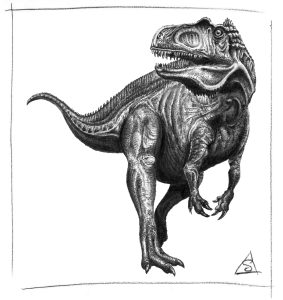 This being the final instalment, I just had to bring back my favourites from the series – the active, sometimes nurturing, often vicious, always fascinating terrors of the mid-Cretaceous, Mapusaurus roseae, Carcharodontosaurus saharicus, Tyrannotitan chubutensis (Matilda), Spinosaurus aegyptiacus, Oxalaia quilombensis, and the petite nightmares, Buitreraptor gonzalezorum. I’ve explained a little about these magnificent creatures within the author’s notes sections of earlier books and hope their deadly reprises got the blood pumping for you again. Each became characters in their own right throughout the series, so there was little room to introduce new animals at this stage (although, for any dinosaur enthusiasts out there, my upcoming NEWFOUNDLAND will be full of similar creatures as well as many new ones). Obviously, in an action series we often imagine such animals at their very worst to work the plot, but I believe the important word there is ‘animals’ – not ‘monsters’. So often dinosaurs are portrayed that way.
This being the final instalment, I just had to bring back my favourites from the series – the active, sometimes nurturing, often vicious, always fascinating terrors of the mid-Cretaceous, Mapusaurus roseae, Carcharodontosaurus saharicus, Tyrannotitan chubutensis (Matilda), Spinosaurus aegyptiacus, Oxalaia quilombensis, and the petite nightmares, Buitreraptor gonzalezorum. I’ve explained a little about these magnificent creatures within the author’s notes sections of earlier books and hope their deadly reprises got the blood pumping for you again. Each became characters in their own right throughout the series, so there was little room to introduce new animals at this stage (although, for any dinosaur enthusiasts out there, my upcoming NEWFOUNDLAND will be full of similar creatures as well as many new ones). Obviously, in an action series we often imagine such animals at their very worst to work the plot, but I believe the important word there is ‘animals’ – not ‘monsters’. So often dinosaurs are portrayed that way. 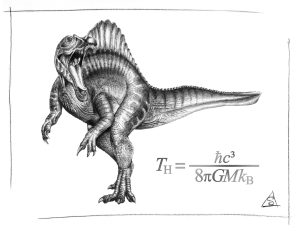 Some may have behaved in ways that would terrify us, almost certainly, but they were no more monsters than a tiger, or a cow for that matter, both of whom also have the capacity to dispatch a man easily – and do. I try to write opposing philosophies in my characters to reflect humanity, and hopefully to avoid tiresome single agendas, but it’s probably no secret that I’ve a deep respect for animals – may even have written about a few! I believe we can learn much from their behaviour, and if I occasionally anthropomorphise them, here and there, to aid the narrative or work out a piece of comedy, my aim has always been to show them simply doing their best to survive good days and bad, just like the rest of us.
Some may have behaved in ways that would terrify us, almost certainly, but they were no more monsters than a tiger, or a cow for that matter, both of whom also have the capacity to dispatch a man easily – and do. I try to write opposing philosophies in my characters to reflect humanity, and hopefully to avoid tiresome single agendas, but it’s probably no secret that I’ve a deep respect for animals – may even have written about a few! I believe we can learn much from their behaviour, and if I occasionally anthropomorphise them, here and there, to aid the narrative or work out a piece of comedy, my aim has always been to show them simply doing their best to survive good days and bad, just like the rest of us.
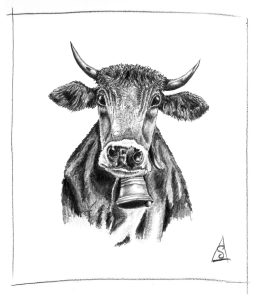
Talking of animals, sometimes, when I offer one of my own furry friends a little treat or reward for being good, I often suspect they understand full well that by sharing such moments they’re rewarding me, too – also for being good, in their eyes. It’s so often true that it’s better to give than to receive, and we humans do like to feel important! They occasionally drive me up the wall, too, but the only time any have ever hurt me is when I’ve lost them, and those are scars I’ll never forget. They remind me what a damned good job they did, every day of their lives, making my life better. I’d hate to live in a world without animals.
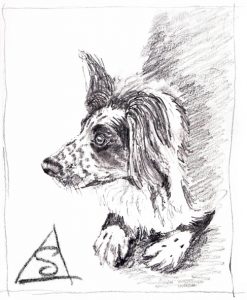
Not that I’d want to be a dino-snack! Again, it’s a matter of respect, and returning to dinosaurs, I did manage to cameo Rebbachisaurus garasbae this time. Barrel-bodied, Rebbachisaurus was a diplodocid – twenty metres and twenty tons of long-necked, long-tailed sauropod majesty, related to the even longer but lighter, and far more famous Diplodocus longus (any who have visited the Natural History Museum in London may be familiar with ‘Dippy’, the full-sized reproduction of the late-Jurassic herbivore who lived fifty million years before Rebbachisaurus). Rebbachisaurus were specifically differentiated by unusually tall dorsal vertebrae along their high backs, giving them pronounced ridges that set them apart from most other sauropods, and even from other diplodocidae cousins. The idea of Rebbachisaurus and the relatively tiny, three-ton Ouranosaurus nigeriensis joining forces to survive the nuclear wasteland was sweet, if sad. For all my fellow animal-lovers out there, fear not! Both made it safely back to their herds in the north, after Heidi and Captain Bessel rudely broke into the narrative and whisked us away to 1940s Germany, taking the granddaddy of all carcharodontosauridae with them!
not a dinosaur!
The other animal I introduced to this story was an outlier, living many millions of years before the mid-Cretaceous and even the dinosaurs themselves in the late Permian Period, 259-252 million years ago. Inostrancevia latifrons was the largest gorgonopsian to live in Laurasia (the northern half of the supercontinent, Pangaea). They must have been truly frightening predators. Larger than Bengal tigers, with massive heads and wickedly large sabre-teeth in their powerful jaws, Inostrancevia, and gorgonopsians generally, were part of the synapsid clade, a major group of the tetrapods that include mammals. Consequently, they were far more mammal-like than the later dinosaurs, and are believed to be part of our own very distant mammalian ancestry. Whether they did indeed have any fur is as yet unclear, but to give an idea of what it would be like to meet one, I suggest watching the very first episode of the British TV show, Primeval, with Douglas Henshall (2007). The writers called the creature Gorgonopsid, but it’s essentially the same beast. You really wouldn’t want to bump into one while taking a stroll one day!
That’s almost it for the animals – just my last old favourite to mention: Sigilmassasaurus brevicollis the spinosaur, and terror of Crater Lake. I had the idea of a throughline between that bad-tempered beastie in Cretaceous Britain and Nessie, several books ago. The idea of an animal surviving untold millions of years in a Scottish loch, a mere 10,000 years old (created by the last ice age) is, of course, perfectly ridiculous – and you could argue that my idea about a time-travelling interloper, laying eggs and raising her progeny to survive a couple of thousand years, isn’t much better, but I couldn’t resist! (NB: I’m not currently sponsored by VisitScotland, but remain open to a retrospective bribe). Naturally, if someone produces convincing new evidence proving the existence of the Loch Ness Monster after this book goes to press, I reserve the right to retract my ‘perfectly ridiculous’ comment and take on an air of smugness, while pretending that I knew all along – please arrange interviews through my publisher and agent; I have history in making up stories 🙂
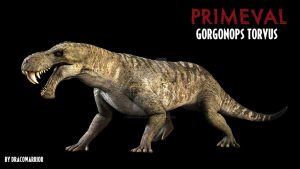
Inostrancevia
Gorgonopsid, late Permian carnivore. Picture from Primeval TV show from Impossible Pictures.
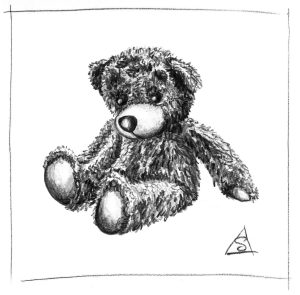
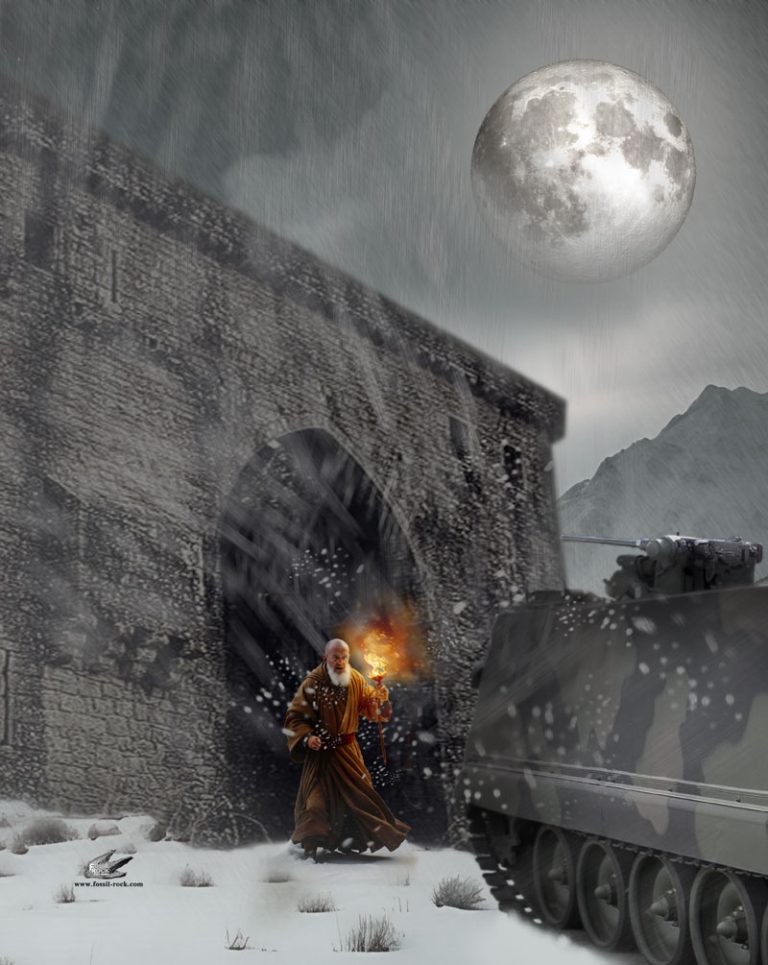
Britain in the Tudor age…
There’s so much back and forth in this book, that I thought I’d try to go through the notes semi-chronologically where possible, and so, moving forward (a long way) to England’s Tudor period, we meet some interesting new characters beginning with the Cout of Kielder…
The heath-bell blows where Keeldar flows,
By Tyne the primrose pale;
But now we ride on the Scottish side,
To hunt in Liddesdale.
Gin you will ride on the Scottish side,
Sore must thy Margaret mourn;
For Soulis abhorr’d is Lydall’s lord,
And I fear you’ll ne’er return.
(excerpt from The Cout of Keeldar, by John Leyden)
That cheery little snippet just about sums up the fate of Sir William de Soulis’ enemies, of whom the Cout o’ Kielder was reckoned one of the greatest of many (as the legend goes). A giant Englishman and Tynedale baron, who allegedly died in the early years of the 14th century – possibly late 13th. As mentioned in previous author’s notes, I brought De Soulis forward to the middle 16th century so that I could include such an authentically historic supervillain within my tale of Hermitage Castle and the Borders (I write a little more about De Soulis and Geoff Lloyd, and their Yuletide antics, in GHOST – part of my New World Extra series).
Information about the cout is sketchy and often contradictory, but it seems he was lauded as a brave young hero type, much admired for his physical size and prowess. While out with a group of friends on a hunt, and who knows what sort of larks, he ignored the local legend about tempting fate when riding anticlockwise, or widdershins, around the Kielder stone (probably the medieval equivalent of reading from the book of the dead in a basement, or repeatedly saying Beetlejuice).
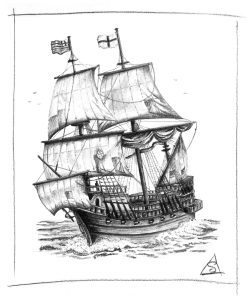 Protected by magic armour (stay with me) he did indeed tempt fate. The rest is history, or more probably, legend. The friends were caught trespassing by De Soulis and invited to Hermitage Castle. Despite De Soulis treating the nobles respectfully, offering them Border hospitality, they began to suspect that he actually intended murder – that seemed to be just how he rolled. Strong and powerful, the cout fought off De Soulis and escaped with his comrades on horseback. De Soulis must have found that irritating, because he and his men pursued them immediately. Enter our friend Robin Redcap. De Soulis’ tame demon helpfully explained that the Cout’s magic armour would not in fact protect him in running water. Doubtless this was sage advice; after all, very few swimmers favour doing the breaststroke in mail! While trying to cross Hermitage Water – the river that ran through Liddesdale and alongside Hermitage Castle itself, and still does to this day – the cout stumbled and fell into a place where the river pooled (a place now known as Drowning Pool). Unable to climb out, the cout was held down by De Soulis’ men with their ‘lang spears’ until he drowned. There’s a grave just outside the small chapel a short walk from Hermitage Castle, marked The Cout o’ Kielder (spelt Keilder on the marker). Against that backdrop, I hope Douglas’ burial of a Mapusaurus thigh bone so that it could be found two millennia later sounds almost plausible. However, modern cynicism aside, these Border tales are a wonderful part of British history and legend, and are not so different from the historic/horror/fantasy fiction we write and consume today. I love them.
Protected by magic armour (stay with me) he did indeed tempt fate. The rest is history, or more probably, legend. The friends were caught trespassing by De Soulis and invited to Hermitage Castle. Despite De Soulis treating the nobles respectfully, offering them Border hospitality, they began to suspect that he actually intended murder – that seemed to be just how he rolled. Strong and powerful, the cout fought off De Soulis and escaped with his comrades on horseback. De Soulis must have found that irritating, because he and his men pursued them immediately. Enter our friend Robin Redcap. De Soulis’ tame demon helpfully explained that the Cout’s magic armour would not in fact protect him in running water. Doubtless this was sage advice; after all, very few swimmers favour doing the breaststroke in mail! While trying to cross Hermitage Water – the river that ran through Liddesdale and alongside Hermitage Castle itself, and still does to this day – the cout stumbled and fell into a place where the river pooled (a place now known as Drowning Pool). Unable to climb out, the cout was held down by De Soulis’ men with their ‘lang spears’ until he drowned. There’s a grave just outside the small chapel a short walk from Hermitage Castle, marked The Cout o’ Kielder (spelt Keilder on the marker). Against that backdrop, I hope Douglas’ burial of a Mapusaurus thigh bone so that it could be found two millennia later sounds almost plausible. However, modern cynicism aside, these Border tales are a wonderful part of British history and legend, and are not so different from the historic/horror/fantasy fiction we write and consume today. I love them.
funny? weird? ironic? It's all just history!
Moving on, I briefly introduced a chap named Captain Fear-God Barebone into this story (we’ll hear more of him in REBIRTH – or a longhand title might be Geoff Lloyd Saves the World – coming soon). My character is not to be confused with the real ‘Fear-God Barebone’, a minor 17th century poet and brother to Anabaptist [1] preacher ‘Praise-God Barebone’, who became a London councillor and member of Oliver Cromwell’s Appointed Assembly – a body that became known as Barebone’s Parliament (probably ironically) – almost a century later, after the civil war. He was imprisoned after the Restoration (the return of Charles II), but was later released to live into old age. The only connection between my character and the man is his name – and what a name. It almost paints a thousand pictures! Ideal for the type of chap I had in mind. The reason I mention this curiosity in my notes is because the Barebone family penchant for uniquely descriptive names didn’t stop with Fear-God. His brother, Praise-God Barebone, had at least two children. Are you ready for these? Jesus-Christ-Came-Into-The-World-To-Save Barebone and If-Christ-Had-Not-Died-for-Thee-Thou-Hadst-Been-Damned Barebone – I kid you not.  Unfortunately, the latter became known simply as ‘Damned Barebone’. For some reason, he wasn’t fond of that moniker, and went by Nicholas instead – parents, honestly! Still, he must have taken the fear of hellfire seriously enough, because he went on to found London’s first fire insurance company and fire brigade. Having read about these men, I simply had to have a Barebone for my story. Isn’t history wild and wonderful?
Unfortunately, the latter became known simply as ‘Damned Barebone’. For some reason, he wasn’t fond of that moniker, and went by Nicholas instead – parents, honestly! Still, he must have taken the fear of hellfire seriously enough, because he went on to found London’s first fire insurance company and fire brigade. Having read about these men, I simply had to have a Barebone for my story. Isn’t history wild and wonderful?
[1] In the broadest of strokes, Anabaptists believe that baptism by water should take place when one is old enough to choose one’s faith. Even when baptised as an infant, they are re-baptised upon reaching an age of maturity, if not actually majority. In Reformation England, such beliefs could be dangerous, dependent on the prevailing orthodoxy of the time and who happened to be on the throne. Most notably, during the Reformation of the 16th century, common folk were encouraged to read the word of God for themselves. Up until then, literacy had been mostly an elite privilege; even many churchmen were illiterate. Whatever anyone’s views about religion, it’s hard to overstate the importance of being encouraged to read – a truly pivotal moment in human history sadly, and yet thankfully, so often taken for granted today.
future technology, or something else?
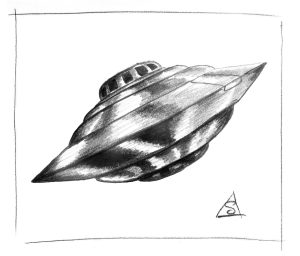
Flying saucer, as described by Bob Lazar.
While on the subject of wild and wonderful, this book alludes to a hearing with Congress on the subject of UFOs – or UAPs, as they’re often termed (unidentified anomalous phenomena) – and the existence of alien technologies that may be in the possession of the US military at Area 53 (I went with Area 51 because it’s more widely known and so required no explanation). Once again, I feel the need to repeat: I kid you not. What I found astonishing, possibly even more so than the discussion itself, was how little the world seemed to care. Have things really become so bizarre over the last few years that real-life aliens are now humdrum? I have no answer to that, but here is a transcript from the news channel that broadcasted it live on the 26th July, 2023.
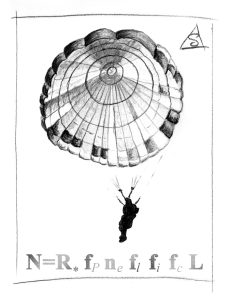 The U.S. House Committee on Oversight and Accountability heard explosive testimony Wednesday, not only about the mysterious craft that was beyond any known technological capabilities but also eyewitness accounts by former US military personnel.[/caption]
The U.S. House Committee on Oversight and Accountability heard explosive testimony Wednesday, not only about the mysterious craft that was beyond any known technological capabilities but also eyewitness accounts by former US military personnel.[/caption]
The hearing entitled ‘Unidentified Anomalous Phenomena: Implications on National Security, Public Safety, and Government Transparency’ heard from: Ryan Graves, Executive Director of Americans for Safe Aerospace; Commander David Fravor (Ret.), Former Commanding Officer United States Navy; and David Grusch, Former National Reconnaissance Officer Representative, Unidentified Anomalous Phenomena Task Force, Department of Defense.
Grusch testified that both he and his wife witnessed ‘non-human[2]’ entities doing harm to humans that he described as ‘very disturbing’.
Graves testified that he had a pilot tell him he almost hit a UAP during take-off: ‘One of these objects was completely stationary… It was right where all the jets were going on the eastern seaboard. The two aircraft flew within 50 feet of the object.’
Upon talking to the pilot after he landed, Graves said he found him with his ‘mouth open’ and that the pilot told him that ‘he almost hit one of those darn things’. Graves said the pilot described the object as a ‘dark cube inside of a clear sphere’.
Source: Global News
Is any of that real? Or true? Can it be true? Is it a hoax? Who knows? It all sounds rather surreal, and that’s putting it mildly. Whether ‘the truth is out there’ remains uncertain, but the full hearing is out there on the Internet – you decide.
[2] I assume they didn’t mean animals.
volcanism
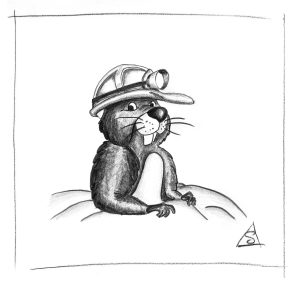 Finally, I come to something a little more tangible – volcanoes. The events here straddle some of the time periods described above, so I thought I’d just tag it on the end. Apologies if the chronology makes anyone twitch. The enormous volcanic event during the Oligocene Epoch of the Palaeogene Period, roughly thirty million years ago, really did happen and really did spew billions of tons of magnetite up from the mantle to create the strongly magnetic Bermuda Triangle – so we can hang on to that. Although, as I type the name ‘Bermuda Triangle’ after discussing UFOs, I feel like I’m disappearing down an entirely different but strangely similar rabbit hole! (Author’s Notes is where I usually attempt to tie the story to real facts and events and discuss any deviances; however, on this occasion, I think reality may have upstaged my fiction.) I’ll try again. The Permian–Triassic extinction, 252 million years ago, definitely happened. Almost everything on Earth died, therefore please note: creating a link between that event and the Oligocene eruption, the way Hiro Nassaki did, would probably not be a good thing… so with that, I’ll end by saying ‘don’t try any of this at home’ and most importantly of all, thank you so much for reading the New World series. It’s been a wonderful journey for me as an author and I hope you’ve enjoyed it.
Finally, I come to something a little more tangible – volcanoes. The events here straddle some of the time periods described above, so I thought I’d just tag it on the end. Apologies if the chronology makes anyone twitch. The enormous volcanic event during the Oligocene Epoch of the Palaeogene Period, roughly thirty million years ago, really did happen and really did spew billions of tons of magnetite up from the mantle to create the strongly magnetic Bermuda Triangle – so we can hang on to that. Although, as I type the name ‘Bermuda Triangle’ after discussing UFOs, I feel like I’m disappearing down an entirely different but strangely similar rabbit hole! (Author’s Notes is where I usually attempt to tie the story to real facts and events and discuss any deviances; however, on this occasion, I think reality may have upstaged my fiction.) I’ll try again. The Permian–Triassic extinction, 252 million years ago, definitely happened. Almost everything on Earth died, therefore please note: creating a link between that event and the Oligocene eruption, the way Hiro Nassaki did, would probably not be a good thing… so with that, I’ll end by saying ‘don’t try any of this at home’ and most importantly of all, thank you so much for reading the New World series. It’s been a wonderful journey for me as an author and I hope you’ve enjoyed it.
Until the next time…
Join the New World series from the beginning…

